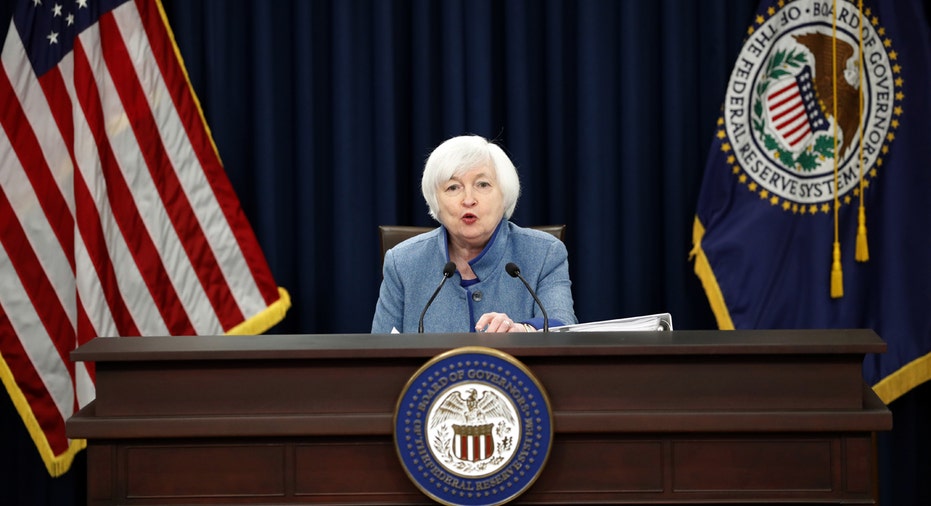Fed Hikes Rates, Yellen Cautious About Future Economic Policies

After a year of anticipation and carefully choreographed public messaging, the Federal Reserve on Wednesday pulled the trigger on raising the short-term federal funds rate – for only the second time since 2006 – and boosted its outlook for the future path of rate increases.
The unanimous decision to hike rates by 0.25 percentage point to a range of 0.50% - 0.75%, came at the conclusion of the policy-setting Federal Open Market Committee’s final two-day meeting of the year. Policymakers cited continued economic improvement including “solid” job gains, higher household spending and rising inflation.
“Our decision to raise rates…is a reflection in the confidence we have in the progress the economy has made and our judgment that progress will continue. And the economy has proven to be remarkably resilient, so it is a vote of confidence in the economy,” Fed Chief Janet Yellen said in a press conference following the 2:00 p.m. ET decision.
The central bank also boosted from two to three its outlook for the number of rate increases it anticipates in 2017. Still, the Fed said the pace of those rate increases would remain “gradual,” as it foresees “moderate” economic growth over the next year. In its economic projections, the Fed estimates a 2.1% annualized pace of economic growth in 2017 alongside an unemployment rate of 4.5% and core inflation rising to 1.9%.
However, the Fed’s rate-hike forecast is reminiscent of last December’s projected four rate hikes in 2016, and is still a bit too aggressive, said KPMG’s chief economist, Constance Hunter.
“We’re operating under a cloud of uncertainty at the moment and we have time to wait and see what changes occur and factor those into our decision making as we gain greater clarity."
“I think the bite out of growth from the higher rates we’ve already seen from the back up in the long end of the curve will mean two rate increases next year,” she said. “Add to that the fact we only need about 134,000 average job growth next year to get to the 4.5% unemployment rate with the current participation rate, and we’re already looking at a slower growth trajectory.”
Indeed, with the unemployment rate at 4.6% in November, and expected to continue declining, the Fed’s focus likely moves more toward boosting inflation, the second part of its dual mandate of full employment and price stability, said David Lafferty, chief market strategist at Natixis Global Asset Management.
“We have probably seen most of the reduction in the unemployment rate that we’re going to see, so what it’s going to take to draw people back into the labor force is higher wages,” he explained.
Higher inflation expectations pushed record-level stocks lower, the U.S. dollar to its highest level since 2003, and Treasury yields up following the decision. The 10-year note yield spiked to 2.523%, its highest level since September 2014.
‘Cloud of Uncertainty’ Looms Over Fed
Last December marked the first time in nearly a decade the Fed raised rates. It was well received on Wall Street, and the central bank said it expected to hike another four times before the end of 2016. However, unforeseen economic events including a global-growth slowdown that spooked worldwide financial markets in the first quarter, the United Kingdom’s June Brexit vote, and the U.S. election last month kept the Fed from further tightening monetary policy as the economy continued to recover from the worst financial crisis since the Great Depression.
Over the last year, though, the economy has shown signs of stability, especially with regard to the Fed’s dual mandate, in the face of one black-swan event after another. The labor market has strengthened with the unemployment rate below 5%, as core personal consumption expenditures price index, the Fed’s preferred inflation gauge, shows inflation moving closer to the 2% target as it hovers around 1.7%. Meanwhile, the economy posted an annualized growth rate of 3.2% in the third quarter as home prices, consumer sentiment and retail sales have been on the rise.
Alongside the improvement, and with the promise of deregulation, more fiscal stimulus through infrastructure spending and lower taxes from President-elect Donald Trump, Wall Street has seen a significant move higher in the weeks after the Nov. 8 election in anticipation of higher inflation. However, Yellen said it’s too early for the Fed to factor in what a future response would be to any of those policy expectations.
“We’re operating under a cloud of uncertainty at the moment and we have time to wait and see what changes occur and factor those into our decision making as we gain greater clarity,” Yellen said. “Market participants are uncertain too, and I would expect changes in our understanding in what’s going to happen to also affect market prices as we move forward.”



















